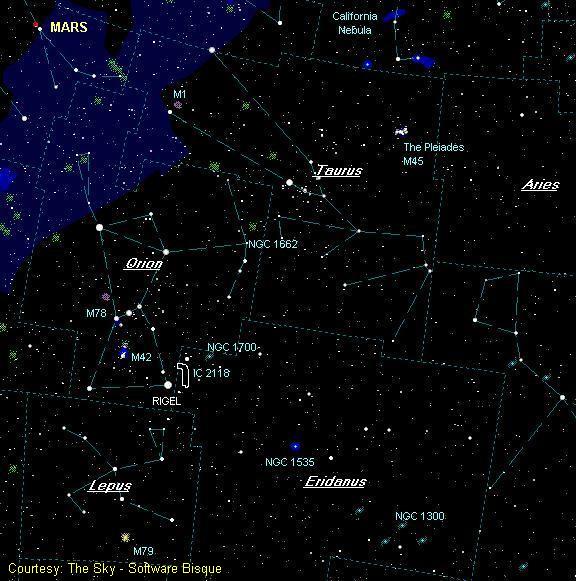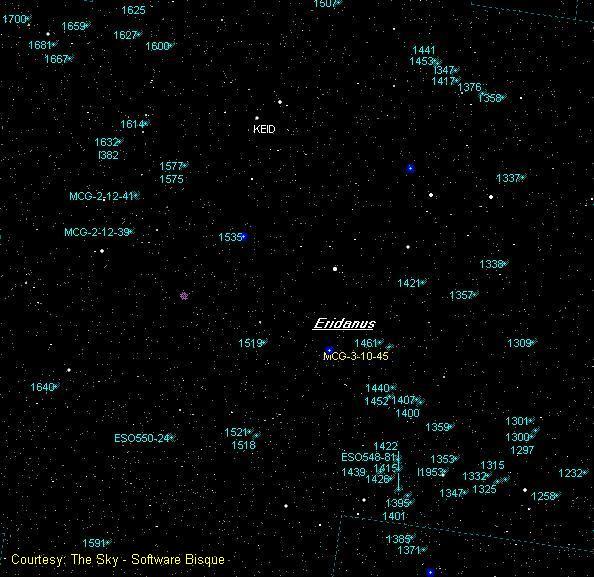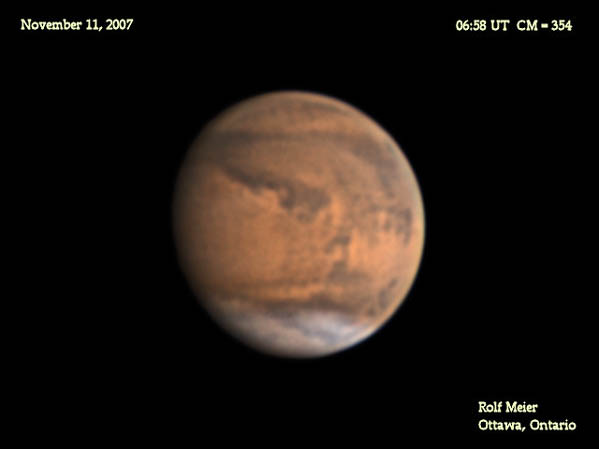Winter’s River
Eridanus the River is a large slinky constellation that continues far below our south Canadian horizon. In fact, the alpha star named Achernar shining as bright as Procyon at magnitude 0.5 is located at declination -57 degrees. This long stretch of celestial landscape is listed as the 6th largest in the sky and is well-populated with many galaxies.
We will start off with a large, faint reflection nebula called the Witch Head Nebula catalogued as IC 2118. It is located two and a half degrees west of Rigel – the right foot of the famous hunter, Orion. Rigel is a blue supergiant star located 770 light-years (ly) from the earth with its light shining with the strength of 40,000 times that of our Sun. This is the celestial lighthouse that is illuminating the IC 2118. But only expect to see this 1000 ly distant patch of faint gas and dust visually except under very dark conditions and with a large scope. With its great dimensions of six lunar diameters long by two diameters wide, it does make a great wide-angle photographic challenge.

A twin of the Eskimo Nebula is Cleopatra’s Eye – NGC 1535. In my 12 Meade LX200, this planetary nebula appears as a magnitude 9.5 patch of light, but it is the colour aqua with a central dot that stands out. It is a must-see on your observing list. If you move ten degrees to the west of Rigel and six degrees north, you will come across a nice group of three galaxies; one edge-on and two elongated. They are listed as NGC 1625, 1622 and 1618. With magnitudes of 12.4, 12.3 and 12.6 respectively, they are housed within a small area only 17 arc minutes.
Next, we will look at a couple of face-on galaxies. Our first stop is NGC 1232 aka the Turbine Galaxy. It lists as magnitude 10.6 and has a faint companion (NGC 1232A) close by. Needless to say, how it got this name, the Turbine is located an estimated 50 million ly and measures the same length as the Milky Way at 100,000 ly. Two and half a degree to the NE of the Turbine is a great example of a barred spiral. Catalogued as NGC 1300, it measures 5.5 X 3 arc minutes and glows at magnitude 10.4.

The multiple star system named Keid is quite interesting as it is a classic example of a white dwarf. Lying a mere16 light-years away, Keid also known as Keid A has two dwarf stars close by namely the B and C components, are white and red in colour and are quite close together. Power is essential. This star system is also known as Omicron 2 or 40 Eridani.
For a real challenge try locating NGC 1532 tugging close to the horizon at minus 33 degrees declination. Dubbed the Woomera Galaxy, NGC 1532 glows at magnitude 11.0 and is estimated to be 70 million ly away. Interacting with 1532 is NGC 1531 and is smaller and fainter at magnitude 12.1. Gravitational forces are affecting each other.
For the past month or so Comet Holmes has put on a dazzling show. Since October 24th, 2007 when Holmes went into outburst gaining a million fold in brightness, the amount of observations and photography is evidence of what we as astronomers love to do. I am sure many sidewalk sessions held outside of bookstores and libraries to promote the night sky and share some of the brighter telescopic views with the general public had this comet in their sights. Holmes is now slowing fading from naked-eye visibility as it and continues to balloon out measuring larger than the Sun. Who knows it might go into outburst again as it did in 1893, only three months after its initial sighting when it first blew its top.
We have finally made it to December – the month of Mars's closest approach. The red planet now rising in the NE after twilight ends, is getting progressively larger and very noticeable until it reaches it’s brightest on Dec 18th at magnitude minus 1.6. Six days later on Dec 24th, it will be closest to us (perihelion) at measure 15.88 arc seconds. At 88.4 million kilometres, it will not come close to the
| Object | Type | Magnitude | R.A. | Dec. |
|---|---|---|---|---|
| IC 2118 | Reflection nebula | Faint | 05h 07m 18.9s | -07° 12' 12" |
| NGC 1232 | Spiral galaxy | 9.9 | 03h 10m 11.3s | -20° 33' 05" |
| NGC 1300 | Barred spiral galaxy | 10.4 | 03h 20m 5.3s | -19° 23' 10" |
| NGC 1309 | Round galaxy | 11.6 | 03h 22m 29.9s | -15° 22' 11" |
| NGC 1337 | Elongated galaxy | 11.7 | 03h 28m 30.9s | -08° 21' 13" |
| NGC 1338 | Round galaxy | 13.0 | 03h 29m 24.3s | -12° 08' 14" |
| NGC 1353 | Elongated galaxy | 11.4 | 03h 32m 29.0s | -20° 47' 16" |
| NGC 1357 | Round galaxy | 13.0 | 03h 33m 36.1s | -13° 38' 16" |
| NGC 1359 | Round galaxy | 12.2 | 03h 34m 11.2s | -19° 27' 17" |
| NGC 1371 | Round galaxy | 11.0 | 03h 35m 22.3s | -24° 54' 18" |
| NGC 1395 | Elongated galaxy | 11.0 | 03h 38m 52.6s | -23° 00' 20" |
| NGC 1421 | Elongated galaxy | 11.4 | 03h 42m 54.1s | -13° 27' 21" |
| NGC 1422 | Elongated galaxy | 13.0 | 03h 41m 52.8s | -21° 39' 21" |
| NGC 1440 | Round galaxy | 13.2 | 03h 45m 23.3s | -18° 14' 23" |
| NGC 1453 | Round galaxy | 11.6 | 03h 46m 49.5s | -03° 56' 22" |
| NGC 1507 | Edge-on galaxy | 12.2 | 04h 04m 55.8s | -02° 09' 32" |
| NGC 1519 | Very elongated galaxy | 13.0 | 04h 08m 29.3s | -17° 10' 36" |
| NGC 1521 | Round galaxy | 11.4 | 04h 08m 40.7s | -21° 01' 36" |
| NGC 1532 | Edge-on galaxy | 11.0 | 04h 12m 26.3s | -32° 50' 39" |
| NGC 1535 | Planetary nebula | 10.0 | 04h 14m 36.1s | -12° 42' 39" |
| NGC 1591 | Elongated galaxy | 13.0 | 04h 29m 45.4s | -26° 42' 49" |
| NGC 1600 | Round galaxy | 11.1 | 04h 32m 7.3s | -05° 03' 50" |
| NGC 1614 | Round galaxy | 12.9 | 04h 34m 24.7s | -08° 33' 51" |
| NGC 1625 | Edge-on galaxy | 12.4 | 04h 37m 31.5s | -03° 16' 53" |
| NGC 1627 | Round galaxy | 13.0 | 04h 37m 55.3s | -04° 49' 53" |
| NGC 1632 | Round galaxy | 13.0 | 04h 38m 18.5s | -09° 29' 54" |
| NGC 1640 | Elongated galaxy | 11.7 | 04h 42m 34.5s | -20° 24' 57" |
| NGC 1659 | Elongated galaxy | 12.5 | 04h 46m 55.3s | -04° 45' 59" |
| NGC 1662 | Open cluster | 6.4 | 04h 48m 58.1s | +10° 57' 00" |
| NGC 1667 | Round galaxy | 12.1 | 04h 49m 1.0s | -06° 18' 00" |
| NGC 1681 | Round galaxy | 13.0 | 04h 52m 7.1s | -05° 48' 02" |
| NGC 1700 | Elongated galaxy | 11.0 | 04h 57m 19.3s | -04° 51' 06" |
No matter, it will still be the talk on newscasts and at public viewing events. One good thing about this approach, it rides highest in the sky at declination at 26 degrees, 46 minutes. On Dec 23rd, the full moon named the Cold Moon will occult Mars but will only be witnessed in the extreme NW of North America. However, three days earlier on the 21st the waxing gibbous moon will cross the Pleiades low in the east as both objects rise in the east. The Maritimes and eastern Canada are favoured for this series of occultations. See how many you can count disappearing and reappearing.
By mid-month, the ringed planet Saturn rises around 11:00 locally. As it appears above the eastern horizon a half-hour earlier each week, it will soon become an all-night object. Saturn’s rings are tilting closed and will keep doing so until the mysterious rings are seen face-on in September 2009. As if we had to be reminded that winter is here, the winter solstice officially begins at 1:08 a.m. on December 22nd with the Sun resting at the lowest point on the ecliptic. If you are in the southern hemisphere, this will be the first day of summer.
Until next month – clear skies everyone and have a happy and safe holiday season.
Gary Boyle

